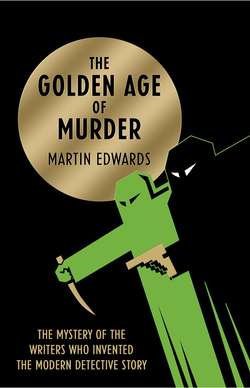Читать книгу The Golden Age of Murder - Stephen Bach, Martin Edwards - Страница 26
Notes to Chapter 5
Оглавление‘snobbery with violence’
This phrase, often attributed to Alan Bennett, seems to have been coined as the title of a pamphlet published in 1932 by Count Geoffrey Potocki de Montalk (1903–1997). Colin Watson, himself a member of the Detection Club, borrowed it for his critique of pre-war thrillers and detective novels.
He remarked to a reactionary acquaintance, Colonel Farquharson
For this anecdote, I am indebted to crime novelist Keith Miles, also known as Edward Marston, who found it in L. G. Mitchell’s article ‘Murder, Univ and G. D. H. Cole’, in the University College Record, vol. xiv, no. 1 (2005).
the Liberal Party and centre-left were well represented among Golden Age authors
To take a few examples, A. E. W. Mason served briefly as Liberal MP for Coventry, and Helen Simpson campaigned as a Liberal candidate prior to her early death. Lord Gorell served in David Lloyd George’s government before defecting to the Labour Party.
One led the Jarrow Crusade, another married one of Stalin’s senior lieutenants, yet another was killed fighting for the Republican cause in Spain.
The writers concerned were Ellen Wilkinson, Ivy Low (also known as Ivy Litvinov) and Christopher St John Sprigg.
Douglas and Margaret Cole were the leading lights of the Left among Golden Age detective novelists.
The Coles’ lives have been extensively documented, with the predominant focus on their political activities. I have found Margaret’s autobiography, her biography of Douglas, and Betty Vernon’s biography of her especially valuable.
Margaret’s brother, Raymond Postgate
Postgate (1896–1971) published three crime novels in all, but neither Somebody at the Door (1943) nor The Ledger is Kept (1953) matched the success of Verdict of Twelve. His father-in-law, George Lansbury, leader of the Labour Party from 1932–35, was grandfather to Angela Lansbury, who played Jessica Fletcher in the television series Murder, She Wrote and Miss Marple in the film The Mirror Crack’d.
Freeman Wills Crofts’ novels about policemen who got results by sheer hard work
Authors whose early work shows the influence of Crofts include not only Douglas Cole and Henry Wade but also John Bude, the name under which Ernest Carpenter Elmore (1901–57) wrote a long series of detective novels.
Crofts explained his painstaking method of story construction in ‘The Writing of a Detective Novel’, reprinted in CADS 54, July 2008 with an introduction by Tony Medawar. Extensive discussion of his life and work is to be found in Curtis Evans’ Masters of the ‘Humdrum’ Mystery. ‘Humdrum’ is a term that Julian Symons applied in Bloody Murder to Crofts, Rhode and certain other novelists who ‘had some skill in constructing puzzles, nothing more’. An entertaining overview of their work is supplied in H. R. F. Keating’s Murder Must Appetize. Symons’ assessment was challenged by B. A. Pike and Stephen Leadbeatter in ‘Give a Dog a Bad Name …’, CADS 21, August 1993. Pike and Leadbeatter are champions of the ‘humdrums’, as is Evans.
T. S. Eliot rated him as the finest detective story writer to have emerged during the Twenties
See Curtis Evans, ‘Murder in the Criterion: T. S. Eliot on Detective Fiction’, in Mysteries Unlocked. Eliot’s other favourite was Richard Austin Freeman, who started writing detective stories much earlier.
Having settled a plot in outline, one spouse wrote a first draft which the couple then discussed and worked on together.
See ‘Meet Superintendent Wilson’ in Meet the Detectives. However, the extent to which the Coles’ books were joint endeavours is open to debate; see Curtis Evans, ‘By G. D. H. AND Margaret Cole?’, CADS 63, July 2012, which strives to identify the books written solely or predominantly by one or other of the Coles.
the Coles kept in touch with the working classes by engaging three servants
The Coles’ novels sometimes offered gentle satire, but penetrating social critiques tended to be in short supply. In Dead Man’s Watch (1931), for instance, the cast includes an eccentric and unpleasant husband and wife called Mr and Mrs Cole, who are members of a Pentecostal sect. Mention is made of a young unmarried woman who becomes pregnant, faints at work, and is sacked when her condition is revealed by the doctor called to attend her, but there is no hint that anyone would or should be surprised by this. Unusually, in Knife in the Dark (1941) a motive for murder is rooted in a xenophobe’s hostility towards foreign refugees; the well-evoked atmosphere of a university town in wartime compensates for a thin plot.
